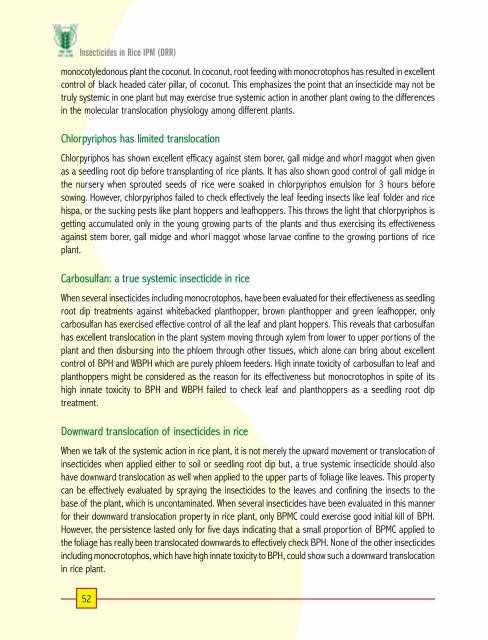priciples of insecticide use in rice ipm
priciples of insecticide use in rice ipm
priciples of insecticide use in rice ipm
You also want an ePaper? Increase the reach of your titles
YUMPU automatically turns print PDFs into web optimized ePapers that Google loves.
Insecticides <strong>in</strong> Rice IPM (DRR)<br />
monocotyledonous plant the coconut. In coconut, root feed<strong>in</strong>g with monocrotophos has resulted <strong>in</strong> excellent<br />
control <strong>of</strong> black headed cater pillar, <strong>of</strong> coconut. This emphasizes the po<strong>in</strong>t that an <strong><strong>in</strong>secticide</strong> may not be<br />
truly systemic <strong>in</strong> one plant but may exercise true systemic action <strong>in</strong> another plant ow<strong>in</strong>g to the differences<br />
<strong>in</strong> the molecular translocation physiology among different plants.<br />
Chlorpyriphos has limited translocation<br />
Chlorpyriphos has shown excellent efficacy aga<strong>in</strong>st stem borer, gall midge and whorl maggot when given<br />
as a seedl<strong>in</strong>g root dip before transplant<strong>in</strong>g <strong>of</strong> <strong>rice</strong> plants. It has also shown good control <strong>of</strong> gall midge <strong>in</strong><br />
the nursery when sprouted seeds <strong>of</strong> <strong>rice</strong> were soaked <strong>in</strong> chlorpyriphos emulsion for 3 hours before<br />
sow<strong>in</strong>g. However, chlorpyriphos failed to check effectively the leaf feed<strong>in</strong>g <strong>in</strong>sects like leaf folder and <strong>rice</strong><br />
hispa, or the suck<strong>in</strong>g pests like plant hoppers and leafhoppers. This throws the light that chlorpyriphos is<br />
gett<strong>in</strong>g accumulated only <strong>in</strong> the young grow<strong>in</strong>g parts <strong>of</strong> the plants and thus exercis<strong>in</strong>g its effectiveness<br />
aga<strong>in</strong>st stem borer, gall midge and whorl maggot whose larvae conf<strong>in</strong>e to the grow<strong>in</strong>g portions <strong>of</strong> <strong>rice</strong><br />
plant.<br />
Carbosulfan: a true systemic <strong><strong>in</strong>secticide</strong> <strong>in</strong> <strong>rice</strong><br />
When several <strong><strong>in</strong>secticide</strong>s <strong>in</strong>clud<strong>in</strong>g monocrotophos, have been evaluated for their effectiveness as seedl<strong>in</strong>g<br />
root dip treatments aga<strong>in</strong>st whitebacked planthopper, brown planthopper and green leafhopper, only<br />
carbosulfan has exercised effective control <strong>of</strong> all the leaf and plant hoppers. This reveals that carbosulfan<br />
has excellent translocation <strong>in</strong> the plant system mov<strong>in</strong>g through xylem from lower to upper portions <strong>of</strong> the<br />
plant and then disburs<strong>in</strong>g <strong>in</strong>to the phloem through other tissues, which alone can br<strong>in</strong>g about excellent<br />
control <strong>of</strong> BPH and WBPH which are purely phloem feeders. High <strong>in</strong>nate toxicity <strong>of</strong> carbosulfan to leaf and<br />
planthoppers might be considered as the reason for its effectiveness but monocrotophos <strong>in</strong> spite <strong>of</strong> its<br />
high <strong>in</strong>nate toxicity to BPH and WBPH failed to check leaf and planthoppers as a seedl<strong>in</strong>g root dip<br />
treatment.<br />
Downward translocation <strong>of</strong> <strong><strong>in</strong>secticide</strong>s <strong>in</strong> <strong>rice</strong><br />
When we talk <strong>of</strong> the systemic action <strong>in</strong> <strong>rice</strong> plant, it is not merely the upward movement or translocation <strong>of</strong><br />
<strong><strong>in</strong>secticide</strong>s when applied either to soil or seedl<strong>in</strong>g root dip but, a true systemic <strong><strong>in</strong>secticide</strong> should also<br />
have downward translocation as well when applied to the upper parts <strong>of</strong> foliage like leaves. This property<br />
can be effectively evaluated by spray<strong>in</strong>g the <strong><strong>in</strong>secticide</strong>s to the leaves and conf<strong>in</strong><strong>in</strong>g the <strong>in</strong>sects to the<br />
base <strong>of</strong> the plant, which is uncontam<strong>in</strong>ated. When several <strong><strong>in</strong>secticide</strong>s have been evaluated <strong>in</strong> this manner<br />
for their downward translocation property <strong>in</strong> <strong>rice</strong> plant, only BPMC could exercise good <strong>in</strong>itial kill <strong>of</strong> BPH.<br />
However, the persistence lasted only for five days <strong>in</strong>dicat<strong>in</strong>g that a small proportion <strong>of</strong> BPMC applied to<br />
the foliage has really been translocated downwards to effectively check BPH. None <strong>of</strong> the other <strong><strong>in</strong>secticide</strong>s<br />
<strong>in</strong>clud<strong>in</strong>g monocrotophos, which have high <strong>in</strong>nate toxicity to BPH, could show such a downward translocation<br />
<strong>in</strong> <strong>rice</strong> plant.<br />
52











